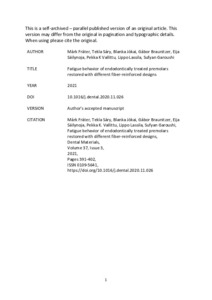Fatigue behavior of endodontically treated premolars restored with different fiber-reinforced designs
Fráter Márk; Säilynoja Eija; Braunitzer Gábor; Garoushi Sufyan; Sáry Tekla; Vallittu Pekka K; Lassila Lippo; Jókai Blanka
https://urn.fi/URN:NBN:fi-fe2021042823200
Tiivistelmä
Objectives: The aim was to investigate the fatigue survival and marginal-gap inside the root-canal of endodontically treated (ET) premolars reinforced by various fiber-reinforced post-core composites (FRCs). Moreover, composite-curing at different depths in the canal was evaluated.
Methods: 170 intact upper-premolars were collected and randomly divided into ten groups (n = 15). One group served as control (intact-teeth). After endodontic procedure standard MO cavities were prepared and restored with different post-core fiber-reinforced materials and designs. Three-group (A1-A3) were restored with either packable and flowable short fiber-reinforced composite (SFRC) core or conventional composite-core. Two-group (B1-B2) were restored with SFRCs as short post (3 mm) and core. Four-group (C1-C4) were restored with SFRCs as post (6 mm) and core with or without unidirectional FRC posts (individually-made or conventional). After completing the restorations, teeth from Group C1-C4 (n = 5/group) were sectioned and stained. Specimens were viewed under a stereo-microscope and the percentage of microgaps within the root-canal was calculated. Fatigue-survival was measured using a cyclic-loading machine in the rest of the specimens.
Results: Application of flowable SFRC as luting-core material with individually-made FRC post (Group C3) did not differ from intact-teeth regarding fatigue-survival (p > 0.05). The rest of the groups produced significantly lower survival (p < 0.05) compared to intact-teeth. Post/core restorations made from packable SFRC (Group C1) had a lower microgap (19.1%) at the examined interphase in the root-canal than other groups.
Significance: The restoration of ET premolars with the use of individually-made FRC post and SFRC as luting-core material showed promising achievement regarding fatigue-resistance and survival.
Kokoelmat
- Rinnakkaistallenteet [19250]
